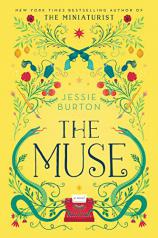The Muse
Review
The Muse
Odelle Bastien is a hardworking émigré from Trinidad trying to carve out a life for herself in London, 1967. When she starts a new job as a typist at the prestigious Skelton Institute of Art, she is beyond thrilled: “The Skelton was Eden, it was Mecca and Pemberley; the best of my dreams come to life.” Fairly quickly, Odelle’s world opens up in ways she never could have imagined, as she is taken under the wing of Marjorie Quick, a chain-smoking, accomplished woman in her early 50s who was second-in-command to Edmund Reede, the director of the Skelton Institute, and referred to in British boarding school style as “Quick.”
When Odelle brings in a painting that her new boyfriend, Lawrie, has inherited after his mother’s death, her bosses are in disbelief at what they see. The canvas that hung in Lawrie’s mother’s bedroom for years just might be one of the very few remaining paintings of Isaac Robles, a young Spanish artist whose untimely and mysterious death derailed a promising career. This discovery leads to a Pandora’s box of intrigue, secrets and lies, leaving young Odelle wondering who she can trust.
"Fans of ALL THE LIGHT WE CANNOT SEE, THE NIGHTINGALE and THE GOLDFINCH will be equally enthralled by this beautifully constructed story of art, ambition and the sacrifices one makes in the pursuit of both."
Arazuelo, Spain, in 1936 was a beautiful little village on the southern coast, free from the hassles of the modern city. Harold Schloss, a Viennese Jewish art dealer, has decided to bring his family here to avoid the growing unrest further north. His wife Sarah, a delicate British heiress, and his strong-willed 19-year-old daughter, Olive, join him in the large, slightly dilapidated house he has rented from a local landowner. To ensure that the household runs well while he’s attending to his business in Paris, Harold hires Isaac and Teresa, the children of the landowner, to help run the property. Teresa is a meek, somewhat sullen girl who becomes the housekeeper, and her half-brother Isaac, an aspiring painter and dilettante caught up in the fervor of revolution that has made its way to the small village, does odd jobs around the estate.
Longing for adventure and excitement, Olive is immediately smitten with Isaac. A closet artist herself, she has never let on to her parents about her artistic ability, including the fact that she was accepted into the Slade School of Art back in London. Olive hides her talent because of her father’s general belief that women are not capable of making truly great art. She confides her skill only to Teresa, who is amazed: “Who painted like this, a nineteen year old in her school pajamas? Who knew such colors, who could take the land she had only just arrived in, and turn it into something better, and higher, brighter than the sun that flooded the room? For surely, this was the finca and its orchard, reimagined in a riot of color and dancing shapes, identifiable to Teresa but so essentially changed.” Sarah, bored with lying around the house while her husband is away, and perhaps seeing the handsome young man as a potential lover, suggests that Isaac paint a portrait of her, as a present to her husband. When Olive hears of this plan, she inserts herself, in an attempt to thwart her mother’s romantic plans, saying “I think Daddy would like us both to be in the painting.”
Right before the painting is to be revealed to Mr. Schloss, Teresa switches out Isaac’s mediocre painting for one of Olive’s, hoping to encourage the young girl to admit to her true ambitions to her parents. Once her father sees her talent, he’ll have to concede that women are capable of great works of art and agree to let her attend art school in London. Mr. Schloss is indeed astounded by the piece, but still thinking the painting is Isaac’s work, he immediately offers to take it to Paris to show to prospective buyers, including Peggy Guggenheim, who was just starting to gain a name for herself as a generous patron of the arts. Despite Teresa’s pleas, Olive refuses to take ownership of her painting: “They believe it’s Isaac’s painting. And that’s all that matters, isn’t it? What people believe. It doesn’t matter what’s the truth, what people believe becomes the truth.”
Olive has fallen so deeply under Isaac’s spell that she begins to feel as if she can’t paint without him. He has become her muse. And Isaac reluctantly goes along with the charade because he channels the money he earns from his newfound artistic fame to his country’s revolutionaries. So what if it’s all predicated on a lie? This one lie is the bitter formation of a conspiracy of deceit that will threaten everyone in its wake, with reverberations that will be felt for decades to come.
Much like her previous novel, THE MINIATURIST, Jessie Burton meticulously reconstructs two different worlds connected by a thread of lies and ruminates on the nature of truth in art. Each seemingly disparate story is told with remarkable care and evident research, and draws the reader in to a serpentine tale about art, truth and artistic ambition. Fans of ALL THE LIGHT WE CANNOT SEE, THE NIGHTINGALE and THE GOLDFINCH will be equally enthralled by this beautifully constructed story of art, ambition and the sacrifices one makes in the pursuit of both.
Reviewed by Bronwyn Miller on July 29, 2016
The Muse
- Publication Date: May 16, 2017
- Genres: Fiction, Historical Fiction
- Paperback: 416 pages
- Publisher: Ecco
- ISBN-10: 006240993X
- ISBN-13: 9780062409935





